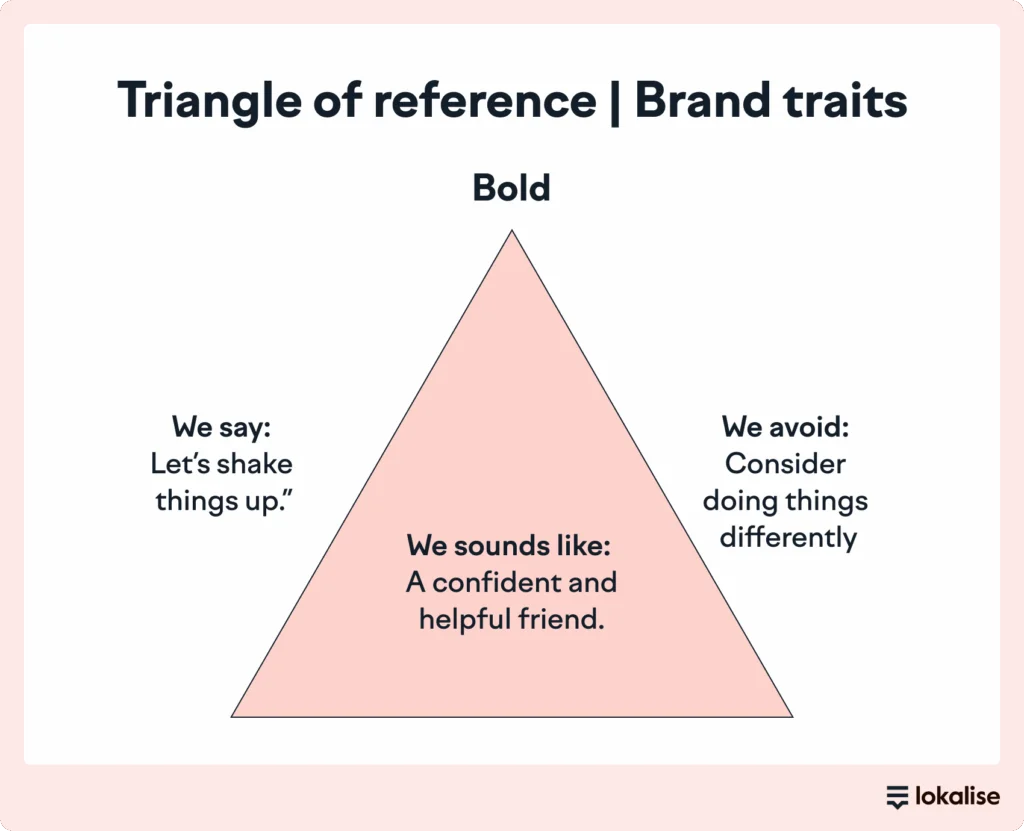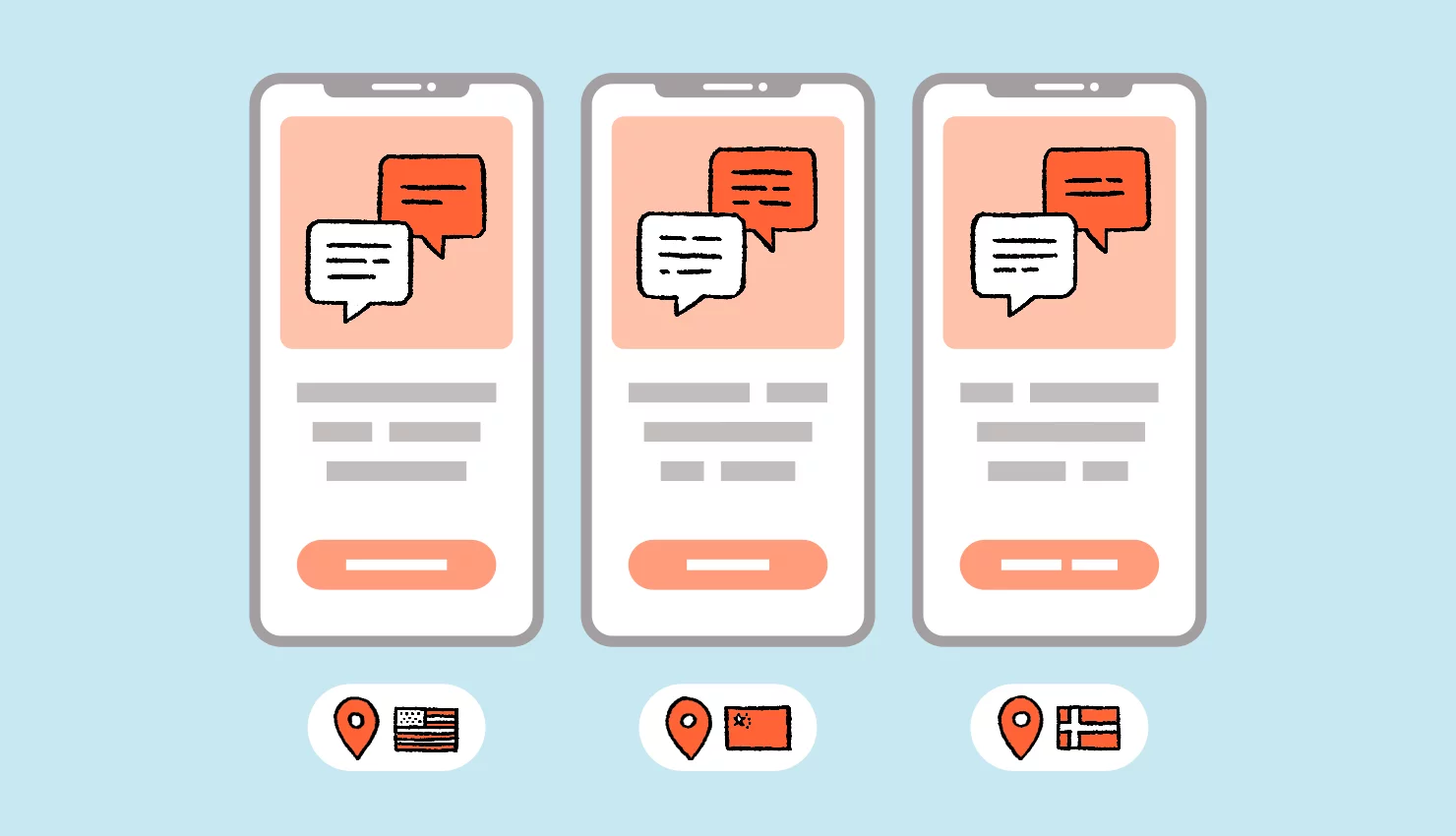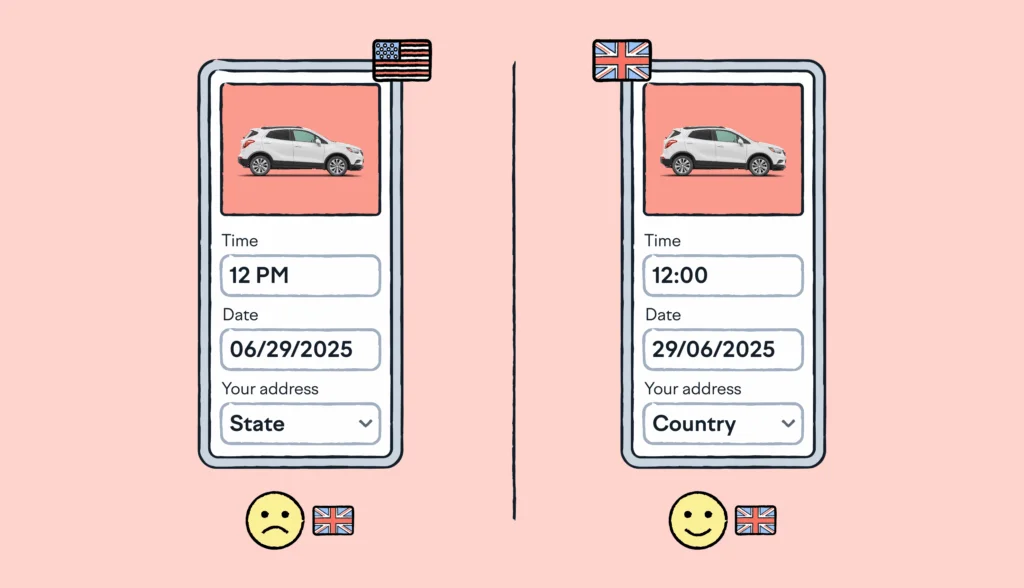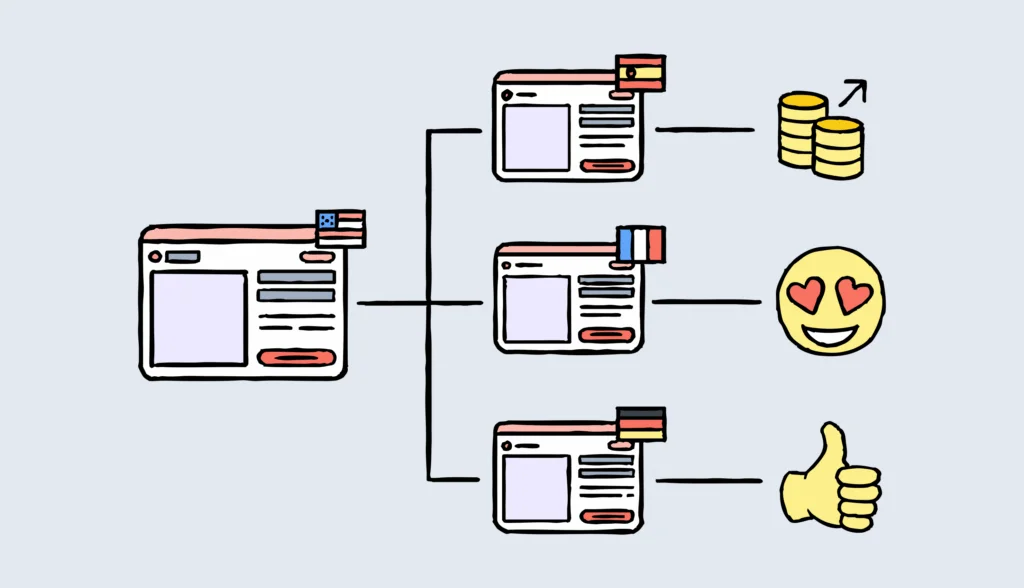Social feeds are crowded, inboxes are full, and ads are everywhere you look. Your audience is short on attention and surrounded by distractions.
How do you cut through these layers of noise and clutter to make your voice heard?
With a tone of voice that sounds distinctively yours.
A strong, consistent tone of voice builds trust, creates emotional resonance, and helps people recognize your brand instantly, no matter where they find you. Without it, your messaging can feel scattered, off-brand, or worse, forgettable.
In this guide, you’ll learn what tone of voice really means, how to define it with clarity, and how brands like Slack and Miro use it to connect deeply with their audience.
What is the brand tone of voice?
Brand tone of voice is the way your brand talks to people. It shapes how you share ideas and connect with your audience in a way that feels true to your brand’s personality and values. This helps people understand what your brand stands for and how they should see it.
In short, your tone of voice guides how you communicate across all channels — whether it’s your website, email, or social media.
Brand voice vs. Brand tone of voice
Your brand voice is your brand’s personality. It doesn’t change.Your tone of voice is your brand’s mood. It changes depending on the situation.
These two concepts are closely connected and make up your brand identity. However, they have different objectives in their communication strategy.
Your brand voice remains consistent across every touchpoint. It reflects your mission and core values, no matter what theme or topic you’re covering. These universal guidelines express your brand identity in every piece of communication.
On the other hand, your tone of voice adapts your brand voice to fit the context and situation. It defines how you showcase your personality in specific situations.
Tone changes depending on:
- Who you’re talking to (a new customer vs. an old one)
- What you’re talking about (a new launch vs. a bug report)
- How your audience might be feeling (excited, confused, upset)
Here’s a quick look at the differences in brand voice vs. brand tone of voice:
| Element | Brand Voice | Tone of Voice |
| Purpose | Expresses your values and core identity | Responds to the audience’s needs and context |
| Consistency | Uniform across all channels and teams | Tailored to specific formats, messages, or emotions |
| Driven by | Mission, values, audience, personality | Intent, audience mindset, and urgency |
| Example traits | Honest, bold, nurturing, witty | Friendly, serious, apologetic, enthusiastic |
Why tone of voice matters
Tone of voice is a critical part of your brand identity.
Your tone brings your brand to life and shapes how people perceive your brand — whether you’re funny, playful, serious, or something else. It can:
- Build trust and recognition: A consistent tone allows people to recognize your brand across different platforms. How? When you talk in the same tone, buyers would associate your brand with a specific voice and instantly recognize you in the crowd.
- Create a strong differentiator: Your tone of voice is a surefire way to cut through the noise of all your competitors. For example, the airline company Ryanair is popular for its social media presence because they have a uniquely unhinged and witty tone of voice.
- Connect with customers: Tone plays a big role in how customers feel about you. You can be a helpful mentor, a relatable bestie, or a meaningful guide. Use your tone of voice to build emotional ties with your audience.
- Create clarity for internal teams: As your brand grows, you’ll have more hands on deck to manage communications for different channels. That’s when well-documented tone of voice guidelines will bring everyone on the same page to avoid any off-brand messages.
Think of your tone of voice as an extension of who you are as a brand. You want to establish these guidelines to always resonate with your audience and not sound out of touch in any situation.
🪴Tone of voice is crucial for localization
When you’re growing your business internationally, a tone of voice document can boost your brand localization efforts. It’s easier to collaborate with translators and reviewers when everyone is following the same guidelines.
What shapes your brand’s tone of voice
Your tone of voice is shaped by several factors that work together to determine how you sound to the world. Let’s look at the most crucial factors to consider when creating your brand tone.
Audience expectations
Your tone starts with the people you’re talking to.
Is your audience made up of growing teenagers, busy parents, college students, business decision-makers, or somebody else? You have to clearly understand who you’re targeting and use insights from audience research to build your tone.
Go beyond demographics to see what excites your audience. Do they respond well to humor, or are they looking for motivation?
For example, TL;DV, a software brand, creates short and funny videos on social media around the pain points of its target buyers. This funny tone helps them resonate with the audience and boost engagement.
Brand values and personality
Your tone should transparently reflect your brand’s core values and personality.
Tie every aspect of your personality to your tone of voice. For example, if you value transparency, your tone should be open and straightforward. And if creativity is a core trait, your copy should feel refreshing or playful.
Focus on your key personality traits and think about how you want to present these traits in your communication.
Content types and platforms
Different channels call for different tones. While your brand voice remains consistent, the way you express your voice (tone) will change based on where you’re speaking.
An Instagram post can be funny and relatable, but a blog post should be informative and engaging.
So, figure out ways to flex your tone for every channel and set guidelines for adapting the tone to varying contexts.
For example, Mailchimp’s style guide has different sections covering tone of voice guidelines for emails, social media, legal, and translated content.
Context and intent
Continuing the point above, your tone changes based on context. Think about: What do I want people to feel after reading this?
For example, you want to sound excited when launching a new product, but be transparent and respectful when explaining a price increase.
In short: Your tone will change based on the stakes, emotions, and purpose of your communication.
Here’s a great example by Duolingo.
The brand’s tone of voice guidelines specify how to adapt the tone based on moments and experiences within the app, covering both positive and negative ones.
How to define your brand’s tone of voice in 6 steps
You’re ready with a marker and a blank whiteboard to map out your tone of voice guidelines. Now what?
Do you simply define what your tone should sound like? Or should you dig into some analysis to brainstorm these characteristics?
I get it — starting from scratch can be overwhelming. That’s why I’ll walk you through six steps to methodically define your brand tone.
1. Audit your current communication
Start by understanding how your brand sounds right now.
Collect examples of your communication and content assets (emails, articles, social posts, etc.) to analyze your current brand tone.
Look for places where the tone hits the mark and places where it feels off. You want to find natural patterns in the way you communicate ideas and messages. Try to pinpoint disconnects between how you intended to speak and how it actually came off.
Besides reviewing what you wrote and how you presented it, think of the audience’s reaction.
Did your social posts spark conversations? Did your emails become a talking point among customers? Did people share your blog posts in numbers? This will show the impact of your tone in action.
To go deeper, you can:
- Interview customer-facing teams to understand what makes people feel excited or enraged
- Analyze your tone across touchpoints to find areas of friction and differences in tone
With this initial legwork, you’re not leaving anything to guesswork. Instead, analyzing your current voice gives you a real-world starting point.
2. Identify your brand personality traits
Your tone flows from your brand personality.
The best starting point for defining your tone is to ask yourself: If your brand were a person, how would you describe them in three or four words?
These words are the personality traits you want people to associate with your brand. For example, a slow fashion clothing brand would choose words like “sustainable,” “environment nerd,” and “eco-conscious” with its brand personality.
Be expressive instead of choosing vague words. For example, ditch terms like “authentic” and “creative.” Instead, zoom in on traits like playful, geeky, witty, humorous, rebellious, and more.
💡Exercise for defining your brand personality traits
Imagine your brand as a person at a dinner party. Now, think of how this person would behave.
Will they crack jokes and make people laugh with their chaotic energy? Will they share deep insights and have interesting conversations? Will they have a serious vibe and ask thought-provoking questions?
Pick three traits for this person at the dinner party. Then, explain what each trait means for your brand.
For every trait you define, ask:
- When do we want to dial it up or tone it down?
- What do we sound like when this trait shows up in our writing?
- Are there moments when this trait would hurt clarity, sensitivity, or trust?
You can create a triangle of reference by defining what to sound like, what to say, and what to avoid.
For example, if one of your traits is “Bold,” your triangle of reference would look like this:
- We say: “Let’s shake things up.”
- We avoid: “Consider doing things differently.”
- We sound like: A confident and helpful friend.

3. Define tone dimensions with examples
Brand tone lives on a spectrum — being “playful” doesn’t mean you have to be “chaotic.” This is where nuance and depth come in.
The NN/g defines four primary tone-of-voice dimensions on a scale of two extremes:
- Formal ↔ Casual
- Warm ↔ Neutral
- Bold ↔ Careful
- Enthusiastic ↔ Matter-of-fact
You have to decide where you sit on each dimension’s scale. Are you more casual than formal, warm than neutral, bold than careful? Carefully think about your brand’s position and define that dimension in your tone of voice guidelines.
If you’re leaning more toward the “Casual” end of the scale, explain exactly how casual you want to sound. Include examples and instructions to specify the level of casual you want to include.
For example, let’s say you want to remind someone of their abandoned cart. You can write: Psst… your cart is missing some things you liked. Let’s fix that.
4. Write nuanced dos and don’ts
The most helpful tone of voice guidelines give context and clear rationale to strike the right tone at the right time.
Make your guidelines actionable and easy to follow for everyone on your team. Here’s how.
Avoid writing abstract ideas like “We’re dynamic.” Explain what it means to be dynamic and how it shows up in your tone. Create a list of dos and don’ts to help your team apply your tone in every communication asset.
For example, Shopify’s tone of voice guidelines give specific directions on how to use different elements in writing. Here’s the dos and don’ts list created for using bulleted lists in communication:
Customize your dos vs. don’ts for every personality trait. And add examples to contextualize your directives. You can also add specific instructions for when it’s okay to bend the rules and practice flexibility within your tone.
5. Tailor tone by context, not just channel
Brand tone isn’t one-size-fits-all. You can’t apply the same tone of voice in every channel, regardless of the kind of audience you’re talking to.
You can be friendly and witty on social media, but inspiring and educational on blog posts. These shifts have to be intentional and well-planned instead of a few random acts.
Create a tone chart to explain exactly how your team can tailor the tone of voice for different channels:
| Channel | Tone | Primary Goal | Example |
| Snappy, playful, high-energy | Grab attention and encourage quick interaction | “Just dropped: New features. Go wild.” | |
| Confident, insightful, slightly formal | Build authority while staying relatable | “We’re rethinking how teams collaborate—here’s what we’ve learned.” | |
| Blog post | Informative, approachable, clear | Educate and build trust | “Struggling with low engagement? Here are three fixes that actually work.” |
| Newsletter | Friendly, concise, action-oriented | Re-engage and prompt click-through | “We’ve picked your favorites—here’s what’s trending now.” |
| Product UI | Crisp, intuitive, reassuring | Support task flow and reduce friction | “Nice! You’ve completed the setup. What’s next?” |
| Help desk email | Warm, human, calm | Reassure, resolve, and restore confidence | “Thanks for reaching out! We’ve got this and will follow up within 24 hours.” |
Once you’re clear on how to adapt your tone by platform, think of how to customize it for different situations and moods — like a product launch vs. a refund request vs. a crisis update and more.
Think of:
- Buyer journey: Are people discovering you for the first time? Are they about to buy?
- Emotion: What is the user/shopper feeling in this situation? Are they excited, frustrated, etc.?
- Urgency: Will people read this message carefully or just skim it?
These three aspects will shape your tone to resonate more deeply with your audience and make people feel seen through your message.
👏 Tailor your voice for every market
Expanding your business to new markets? Make a plan to adapt your tone for local audiences based on their cultural and behavioral preferences.
6. Create a tone of voice playbook
Now that you’ve built your tone of voice, don’t let it live in your head. A documented brand tone keeps your communication consistent, no matter who’s writing.
Create a visual style guide with all the guidelines, directives, and examples to implement your tone of voice. You can add writing templates and real-world use cases to help your team strike the right tone in every context.
Remember to make this guide easy to access and follow.
So, save it in a centrally accessible place like a Notion doc or a Miro board. And keep it short and to the point to avoid confusing readers.
Most importantly, make your tone playbook a living document. You can encourage writers, designers, and everyone in your team to contribute to this guide with real-life examples. Let the guide evolve from hands-on work, not just top-down direction.
4 real-world brand tone examples for inspiration
Let’s look at real-world examples of brands with well-documented tone of voice guidelines.
Each one takes a different approach, but they all achieve the same goal: helping teams write in a way that sounds unmistakably “them.”
1. Intuit
Tone of voice guide: Read here
Intuit’s tone guidelines focus on building trust through clarity in communication. The fintech brand offers a suite of products and aims to strike a consistent tone for all its products.
They aim to sound approachable, helpful, and friendly without oversimplifying information. The tone changes depending on people’s needs and emotions. They want to simplify financial decision-making and guide people toward a better future by embracing the personality of a helpful friend.
2. Miro
Tone of voice guide: Read here
Miro’s tone of voice document focuses on personality traits like encouraging and energetic.
Their tone uses forward-leaning verbs, high-contrast phrases, and short, expressive lines that make even dull messages feel exciting.
The goal is to reflect the appeal of Miro’s product by using action-oriented verbs and creativity. They want to give optimism the center stage and give users a positive feeling about everything they can do with Miro.
3. Slack
Tone of voice guide: Read here
Slack’s tone of voice guidelines prioritize clarity over cleverness. Their voice is confident, direct, and human. The guidelines strictly advise against using jargon and fluff that might confuse people.
Their tone of voice balances friendly communication with professional clarity. So, even when being playful, they keep things clean and avoid being insensitive or too witty. Function comes first with the goal of making workplace tools feel more human and less mechanical.
4. Victor Harbor
Tone of voice guide: Read here
Victor Harbor’s tone of voice guide is grounded, friendly, and proud. It targets three different audience segments with varying personality traits and tone for each one.
For every segment, the guidelines specify the kind of phrases to use and avoid. They also show examples from real-world and fictional communication to show every advice in action.
Make your brand tone a strategic asset
When you have a consistent tone of voice, people will recognize and recall your brand.
The right tone helps your brand show up with intention, sound consistent across touchpoints, and create deeper connections with your audience. The brand tone guidelines also reinforce who you are.
So, start with what your brand currently sounds like and then define how you really want to speak to your audience. Then, follow the steps I’ve outlined in this guide to brainstorm, document, and refine your tone guidelines.





